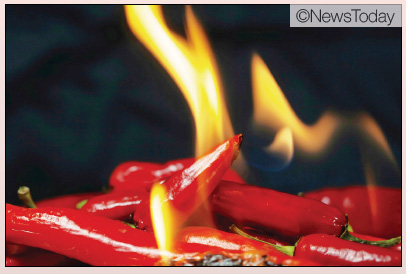
According to Doopedia, spicy refers to a taste that is stimulating enough to cause pain. It is generally accepted that a certain degree of spiciness helps relieve stress and promotes appetite to activate digestion. Therefore, many dishes use hot spices like chili pepper or Chinese pepper combined with garlic, onion, and horseradish.
The boom in demand for spicy cuisine, which began with grilled chicken feet, jjamppong, and tteokbokki, has recently become more intense with a demand for a wider variety of even spicier foods. Mala, a spicy and numbing seasoning made from Sichuan peppercorn and chilly has recently appeared on the radar of social media users. Mala Tteokbokki was recently a hot topic on social media even before its official launch. In addition, as soon as it was released, it was temporarily sold out because of its popularity. Mala Rosé Jjimdak combines not only the taste of “Mala” but also the taste of “Rosé” to showcase a new taste that has never been eaten before. Both dishes present a perfect fusion-style of spicy taste that adds ingredients for Chinese spicy hot pot such as Chinese glass noodles and bean curd sheets. Recently people can truly choose food of any level of spiciness according to their preference. In the case of GS25 convenience stores, the sales and variety of spicy foods on offer have steadily increased over the past three years. The number of spicy flavored products increased from 117 in 2021 to 142 last year and 174 this year. Nongshim has released a limited edition of “Shin Ramyun The Red,” which enhances the existing spicy taste by increasing the amount of Cheongyang red peppers. Ottogi launched a “spicy yeollamyeon” adding spices like garlic and pepper. Spicy taste is becoming a trend in desserts too with the emergence of spicy ice cream and spicy snacks as well.
There is a word that expresses the love of Koreans for this spicy taste, and it is “Maepbusim”. Maepbusim, which is often seen in product names, is a new word that combines two words meaning “spicy” and “pride,” which refers to pride in the ability to eat spicy food well. On the other hand, there is also “Maepjjiri,” which refers to people who cannot eat spicy food well. The two newly coined words are pleasant expressions of the degree to which one is able to eat spicy food. Then, exactly how spicy is K-Maepbusim and why do Koreans love spicy food so much?
What kinds of spicy flavors are there?
There are many kinds of spicy flavors that koreans love. As mentioned above, there are three main types of spicy taste that can be felt with the human mouth. The first is Capsaicin, which is contained a lot in red peppers. Capsaicin has an antibacterial effect and is also effective in preventing obesity. The second is Allicin in garlic and onions. Allicin is known to help people digest and lower cholesterol levels. The last is in the Piperine in pepper. Piperine has the characteristic of being easy to digest because it promotes the secretion of digestive fluid. Of course, these various spicy flavors originated not only in korea but also in many countries. Now, what kind of spiciness do readers enjoy and like?
When did Korea start using Chili pepper powder?
Chili peppers are used to add the spicy flavor to Korean food. The annual consumption of chili peppers per Korean is estimated to be about 4kg, with an average daily intake of approximately 11g. It is uncertain when chili peppers, which originated from South America, were introduced to Korea. However, the most plausible theory suggests that chili peppers were brought to the Korean Peninsula after being delivered to Nagasaki, Japan by Portuguese merchants in the mid-16th century. For a long time, however, chili peppers were treated as an inedible crop. In Jibong-Yuseol, the first Joseon Dynasty encyclopedia to mention chili peppers, it is written that chili peppers are said to contain strong poison.
It was only after the 18th century that chili peppers were used in food in Korea, and this was caused by a surge in the price of salt. As the Confucian educational institutions of Hyanggyo and Seowon increased in Joseon, ancestor memorial services also increased. Thus, the demand for salt, which was necessary to prevent the decomposition of fish used for the ceremony, increased rapidly. In addition, because of a breakthrough in the cultivation of rice, where rice was first grown in a seabed, and then transplanted to a paddy, the production of rice soared. As the demand for rice increased the demand for side dishes increased, and along with it, people started seasoning their food with chili pepper powder instead of expensive salt. Until then, Gimchi was made by soaking vegetables in brine, like Baekgimchi. Thereafter, people used chili pepper powder to spice it, giving Gimchi the distinctive red color that people now know.
Can eating spicy food alleviate stress?
How does our body experience spicy flavor? As everyone knows, spicy is not included in the category of flavors. There are no taste buds on our tongues that can detect spicy flavor and spicy taste is just the sensation of pain that stimulates the pain receptors which cannot distinguish between spicy and hot sensations. That is why human sweat when they eat spicy food. The more receptors individual people have on their tongues, the more sensitive they are to spicy flavors. Conversely, the fewer receptors they have on their tongue, the less spicy sensation they experience allowing them to eat spicy food well. Therefore, please note that people cannot practice eating spicy in order to improve their ability.
Eating spicy food relieves stress by provoking pain in body, which causes the brain to secrete endorphins. Since endorphin is a natural pain killer, it makes people feel pleasant and relieves stress. In fact, in Europe, chili peppers were used as medicine in the early days of the chili pepper trade. Nicholas Monardes, a Spanish doctor in the 16th century, wrote in his book that eating chili peppers is effective in curing chest diseases as it energizes the body and calms the mind.

How did Koreans become so proud of their spicy taste?
Until the 1960s, Korean food was not as spicy as it is now. Due to low chili pepper production, the types of spicy food were minimal and the level of spiciness was not that strong. Korean food gradually became spicier, through the improvement of various species of chili peppers. The production of chili peppers gradually increased, and finally the Cheongyang red pepper was cultivated. There are many opinions about the origin of the name of Cheongyang red peppers, but according to past interviews by a breed developer Dr. Yu Ill-woong, it was named Cheongyang, after the regions where it was developed. According to him, people took the Cheong from Cheongsong and Yang from Yeongyang-gun to create the name.
The spicy taste of Korea spreads all over the world since the Seoul Olympics in 1988. During that time, Korean spicy food like Gimchi, Korean ramen, Bibimbap, and Dak galbi was introduced to the world, and the preconception that Korean food is spicy, arose. The taste columnist Hwang Gyo-ik commented during an interview with Woman-Chosun, “The concept that Koreans like spicy taste was made at the Seoul Olympics. This was because the media portrayed it as a special symbol of Koreans after seeing them daily eat spicy food.”
Originally Koreans preferred a mild sweet and spicy flavor made from chili pepper powder and red chili paste. However, in 2012, Samyang Food’s Buldak Artificial Spicy Chicken Flavor Ramen, started adding hot chili sauce the traditional recipe. This concoction, which was spicy enough to make tongue ache, quickly became very popular. Also eating spicy pork cutlet and spicy jjamppong along with Buldak artificial spicy chicken flavor ramen, hot enough to make eyes tear up, become a trend. A new kind of spicy taste was placed on peoples’ tables. Since then, as awareness about Korea has increased along with the K-culture, overseas interest in Korea’s spicy taste has also been increasing.
There are some side effects that readers should consider before indulging in hot spicy food. Excessive spicy food can lead to abdominal pain, heartburn, and stomach ulcers. It is also one of the factors that increase blood pressure. Capsaicin can irritate the stomach when used for a long time and impact the activity of colon tissues, according to a paper published in Volume 29, No. 4 (1996) of Anatomy and Cell Biology. However, there are currently no specific criteria to refer to when eating spicy food except the Scoville scale, which measures the level of spicy food. In an interview with New Today, Lee Soo-hyun, head of the Consumers Korea, said, “Currently, there are no sanitary or clear standards in spicy tastes, and it is classified as a matter of personal preference.”

By Kim Ji-soo
sixteen@chungbuk.ac.kr
By Choi Yun-Ji
2022009010@chungbuk.ac.kr


 All
All Culture
Culture






 Kim Ji-soo
Kim Ji-soo











